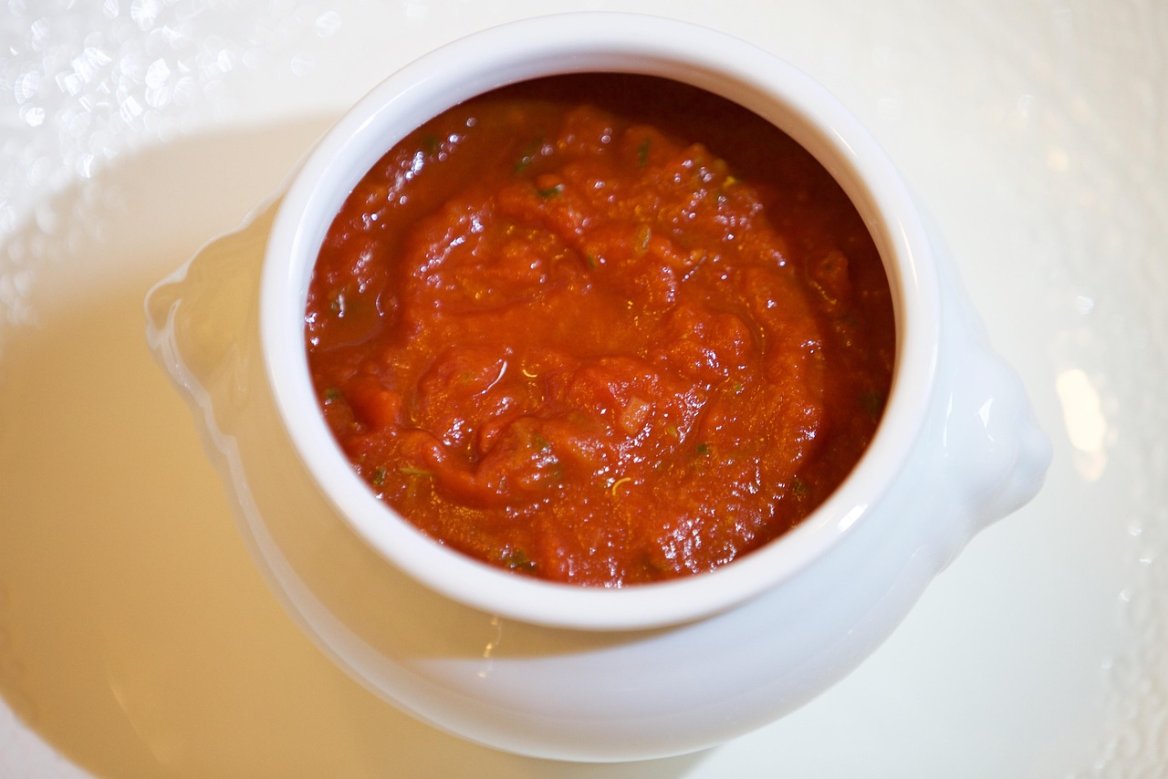Ingredients:
1 small (6 ounce) can tomato paste plus 1 can of water
1 medium can (14 ounce) tomato sauce, plus 1 can of water
1 large can (28 ounce) tomato puree, plus 1 can of water
(The following spice and herb amounts are approximate:)
¾ tsp salt
⅛ tsp black pepper
¼ tsp garlic powder
1 large bay leaf
½ tsp dried oregano
¾ tsp dried sweet basil
½ tsp fennel seeds (optional)
Optional: Add uncooked or cooked meatballs or leftover pieces of meat that you wish. Many people like to start with chopped onion, celery and carrot for a sweeter sauce.)
Directions:
Combine tomato ingredients and water in a large Dutch oven or saucepan. Add herbs and stir on low heat until well combined.
Simmer on low for at least one hour and up to 4 hours, stirring occasionally, resulting in a rich thick sauce as shown in the photo above by Tjena on Pixabay. Add water, if sauce becomes too thick.
Adjust spices and herbs to your taste. If the sauce becomes too bitter tasting, add granulated sugar, 1 tsp at a time until it suits you. The addition of a piece of carrot may also add sweetness.
Notes: This sauce may be frozen or canned. It can also be made in a crock pot on low heat. Stir occasionally and add water as needed.
If you would like to be notified when we share new recipes, be sure to scroll to the bottom, provide your email address, check the box confirming you are not a robot, click on a few photos to prove it and click subscribe! You will then receive an email after each new post. Remember, we're always looking for new recipes and stories, so keep sending them to ecopact@fspa.org!
Story:
I learned to make sauce (called gravy by my Nana) by watching her add a pinch of this and that to canned tomato products. The recipe above is the result of my daughter asking for measurements to make Italian sauce from scratch. Whenever I make it, the kitchen if filled with memories of my roots and Sunday meals with Aunts, Uncles and cousins called to the table with the invitation “mangiare”, “to eat!”
In a similar story, a Guatemalan woman returned to her home town with friends from the U.S after many years away from her birthplace. When she tasted a favorite childhood dish, she literally wept when a deep emotional connection to her people was reawakened through its taste, texture and smell.
If we have lost food memories as a source of deep connection, we can create new ones through mindful eating and cooking of traditional foods. We can create solidarity with others and find motivation to help protect our food system.
The Seasoned Franciscan recipe series has offered invitations to transform hunger and our food system so that no one is hungry for food, for love, for God’s justice. As the Unite Nations celebrates World Food Day, consider one of those invitations to transform agri-food systems to ensure that everyone has a healthy diet and lives in harmony with the planet.
Invitations:
- Make food that creates and deepens memories and traditions from your own ethnic roots and from those of other cultures you value. Consider a Thanksgiving that uses traditional First Nation Foods or those of your own heritage.
- Gifts of food to friends and strangers are important. Reach out to food rescue, food pantries, meal programs in your area (Hunger Task Force, WAFER, Catholic Charities’ Warming Center) to share God’s abundance with people facing insecurity in food, housing and more.
- Make financial donations and membership in UNICEF, Bread for the World,
- Purchase food from local farmers, food that is environmentally sound, that is fairly traded, low on the food chain and that offers a fair wage to those who plant and harvest - all contribute to a healthy food system.
- Any contribution you make to turn back climate change affects our interconnected food system of crops, livestock, forestry, and fisheries and aquaculture as well as farmers, eaters, businesses. Whatever we can do to influence large agribusiness to invest in people and land rather than only in profitability can safeguard our food system.





Post a Comment